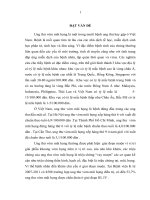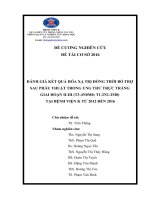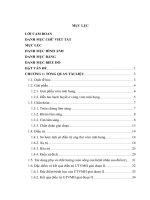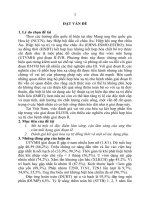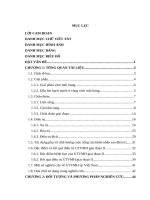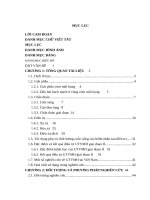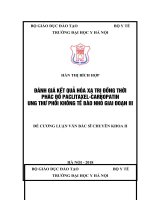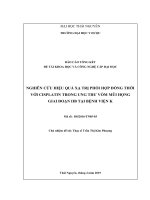Đánh giá kết quả hóa xạ trị đồng thời trong ung thư vòm mũi họng giai đoạn II tại bệnh viện k tóm tắt LUẬN án TIẾNG ANH
Bạn đang xem bản rút gọn của tài liệu. Xem và tải ngay bản đầy đủ của tài liệu tại đây (446.28 KB, 24 trang )
1
INTRODUCTION
1. The reason to choose the dissertation
According to the guideline of National Comprehensive Cancer
Network (NCCN) or European Head and Neck Society-European
Society for Medical Oncology- European Society for Radiotherapy and
Oncology (EHNS-ESMO-ESTRO), concurrent chemoradiotherapy
(CCRT) with or without adjuvant chemotherapy is recommended for
nasopharyngeal carcinoma (NPC) stage II-IVB. The role of this
modality on local-regional control and metastasis prevention has been
proved by many randomized studies for stage III-IVB. For stage II
NPC, there were several studies on chemoradiotherapy, however, the
evidence of the effectiveness has been not strong enough. Apart from
the supporting views, there are controversies about the role of this
regiment. Some researchers suggests it is possible that chemotherapy
has been overused in clinical practice without substantial survival gain,
especially in the IMRT era. Moreover, the use of chemotherapy may
increase the rate of acute and chronic toxicities affecting to the patients
quality of life, which is very important issue for the early stage patients
who have opportunity of long time survival.
In Vietnam, most of studies on the role of chemoradiotherpy were
conducted for stage III-IVB NPC, but not for stage II.
2. Purposes
1. Evaluate the clinical and some subclinical characteristics of
stage II nasopharyngeal carcinoma.
2. Assess the effect of concurrent chemoradiotherapy and several
toxicities.
3. The contribution of the thesis
NPC stage II was more common in male than female
(male/female: 1.8/1). The age group of 40-59 was most common (66.2%).
Cervical lymph node (LN) was the first clinical symptom and most
common at the time of hospitalization (33.9%, 90.3%). The time of
hospitalization < 3 months was highest (56.5%). Parapharyngeal space
(PPS) invasion: 45.2%. Level II LN was prominent (87.5%). The size of
LN was mostly < 3cm (T2N0, T1N1, T2N1 were 9.7%; 54.8%; 35.5%,
respectively). The undiferrentiated carcinoma of nasopharyngeal type
(UCNT) was most frequent (96.7%).
Tumour and LN complete response rate (CRR) and partial
response rate (PRR): 93.5% and 6.5%. 1,2, 3-year overall survival (OS):
100%; 93.4%; 88.7%, respectively. Medium survival time: 41.3 months.
2
3-year disease free survival (DFS) rate: 86.0%. The poor prognosis for
the OS: PPS invasion, ≥3-6cm LN, delay time of treatment > 2 weeks
(p<0.05), of which PPS invasion and node size were independent
prognosis factors.
Acute toxicities grade 3: leucopenia 9.7%, neutropenia 9.7%,
dematitis 17.7%, mucositis 24.2%, vomiting 9.7%. There were no renal
and liver toxicities. Chronic toxcicities: xerostomia grade 3: 21.5%,
trismus grade 1-2: 16.1%, skin fibrosis grade 1-2: 48.2%.
Global health status score: 61,1. According to QLQ C30 some
good functioning scores: physical functioning (79,2); role functioning
(68,2); cognitive functioning (81,5); bad symptom scores are: financial
problems (48,8); appetite loss (39,5); fatigue (29,8) and insomnia
(20,9). According to QLQ-H&N35 bad scores: dry mouth (59,3); sticky
saliva (49,3); teeth (34,5); weight loss (31.5).
4. The structure of the thesis
The thesis contains 120 pages with 4 chapters: Introduction 2
pages, chapter 1 (review) 41 pages, chapter 2 (study method) 14 pages,
chapter 3 (result) 23 pages, chapter 4 (discussion) 37 pages, conclusion
2 pages and 1 page of recommendation.
There are 31 tables, 10 images, 13 figures, 146 references (13
Vietnamese documents, 133 English documents)
CHAPTER 1. REVIEW
1.1. Epidemiology of NPC
1.2. Anatomy
1.2.1. Anatomy of the nasopharynx
1.2.2. Lymphatic drainage of the nasopharynx
1.3. Diagnosis
1.3.1. Clinical diagnosis
1.3.2. Subclinical diagnosis
1.3.3. TNM staging: using the guideline of the seventh edition of
the UICC/AJCC staging system (2010).
1.4. Treatment
1.4.1. History of NPC treatment modalities
1.4.2. Radiotherapy
Radiotherapy (RT) technique: 3 dimentional RT, Intensitymodulated radiation therapy (IMRT), Image-guided radiation
therapy, of which 3D technique is chosen for this study.
1.4.3. Chemotherapy
3
- Modality of chemoradiotherapy combination: CCRT, neoadjuvant chemotherapy, adjuvant chemotherapy, neo-adjuvant
chemotherapy with CCRT.
- CCRT with Cisplatin 30mg/m2, weekly for 6 weeks and CCRT
with Cisplatin 100mg/m2, day 1,22,43.
1.4.4. Target therapy
1.5. Toxicities and quality of life after treatment
1.6. Characteristic of NPC stage II and treatment outcomes
1.6.1. Characteristic of NPC stage II
1.6.2. Treatment outcomes
Studies of NPC stage II on the world
Xu (2011) conducted the research on 392 patients diagnosed with
T2N1M0 NPC (CCRT vs RT alone). The results: 5- year recurrent free
survival rate of CCRT group was higher than the that of RT alone group
(91.5% vs 77.3%; p=0.007).
Chen (2011) showed that the the rate of 5-year OS, LRRFS, DMFS
of the NPC stage II patients of CCRT group was significiant higher than
the that of RT alone group (94.5% vs 85.8%, p=0.007; 87.9% vs 77.8%,
p=0.017; 94.8% vs 83.9%, p=0.007).
With the advace of RT technique, up today, IMRT not only gives
the better survival but also considerably decreases the rate of toxicities
and contributes to improving the quality of life for the NPC stage II
patients vursus 2D or 3D RT.
According to Luo: 3-year OS rate of CCRT (IMRT) was higher
than that of IMRT alone (100% vs 81.4%, p=0,04).
The study of Kang (2015) on 138 patients NPC stage II treated
with RT (3D and IMRT) from 12 hospitals of Korea (RT, neo-adjuvant
chemotherapy + RT, CCRT, NAC+ CCRT, AC) showed: 5-year LRRFS,
DMFS, OS rate was 86.2%; 85.5%; 88.2%, respectively. The the rate
of 5-year OS, DMFS, LRRFS, DFS of Guo study on 311 patients
treated with CT+IMRT in 2016: 91.1%; 90.6%; 95.9% and 87.6%.
Lu Ning Zhang (2015) in a multivariate analysis on 661 NPC
patinets stage II and T3N0N0 treated with IMRT+ CT showed that
CCRT did not decrease the risk of mortality, metastasis and localregional recurrence.
Fan Zhang (2015) also conducted a study on 440 patients stage
II and T3N0M0 (IMRT alone and CCRT). There was no difference of
survival rate (OS: 98.2% vs 98.9%; p=0.276), but the rate of acute
toxicity increased gradually in the CCRT group.
4
Pan (2017) also found that there was no difference of 5-year OS,
LRRFS and DMFS rate between the CCRT and RT (2D and IMRT
alone). The researcher noted that patients treated with IMRT had the
lower rate of acute and chronic toxicities.
Xu (2017) showed the difference of OS and LRRFS of CCRT vs
IMRT alone in a meta analysis study on 2,138 patients: HR=0.67; 95%
CI=.,45-0.98; p =0.04 and HR=0.61; 95% CI:0.46-0.80; p=0.0003).
However, the rate of toxicities was higher.
Recently, Liu, in another meta analysis study also concluded that
CCRT did not improve the OS in comparison with IMRT alone
(HR=1.17; 95% CI 0.73–1.89; p=0.508).
In brief, many researchers confirmed that CCRT is effective for
NPC stage II. However, IMRT, the modern technique of RT has not only
given the same suvival as CCRT but also improved the quality of life
for the patients.
1.7. Studies on NCP in Vietnam
1.8. Chemotherapy agent used in study
CHAPTER 3. STUDY METHOD
2.1. Patients
62 patients diagnosed with NPC stage II and treated with
weekly Cisplatin based CCRT at K hospital from 4/2014 to 4/2017.
2.1.1. Eligibility criteria
Patients at the age of 18 to 70; PS <2; diagnosed with NPC with
tumour or LN biopsy- proven; using the guideline of the seventh
edition of the UICC/AJCC staging system (2010) for TNM
staging; this is the first time of diagnose and treatment; having no
contra-indication of chemo radiotherapy; explained clearly about the
treatment duration and agreement with the treatment plan; having good
keeping medical records; having information after treatment.
2.1.2. Exclusion criteria
Patients discontinuing treatment not for special reasons; having
comorbidities which is not suitable for CRT; having mental diseases;
incompletion of the self-reporting questionnaire.
2.2. Study method
2.2.1. Study design: Non randomized clinical trial
2.2.2. Sample size: 62 patients
2.2.3. Time and place of study: the study was carried out from 4/20144/2018 at K hospital.
5
2.2.4. Procedure of examination, diagnosis, treatment and follow up
2.2.4.1. Examination and diagnosis
- Physical examination, nasopharyngoscopy
- Subclinical examination: tuomour or LN biopsy, MRI or CT
scan of the nasopharynx and neck, chest radiology, abdominal
sonography, bone scan, hematology test, liver and renal function test.
- Diagnose.
- TNM staging: used the guideline of the seventh edition
of the UICC/AJCC staging system (2010).
2.2.4.2. Treatment: NPC patients were treated with CCRT
- RT: 3DCRT in two phases. The dose of RT for primary tumour
from 66-70 Gy, for the positive LN 66-70Gy, whole cervical LN
prevention 50Gy, 2Gy/day, 5 days per week.
- Chemotherapy (CT) based on weekly Cisplatin 30mg/m2 in 6 weeks.
2.2.4.3. Evaluate the results and follow up
- Evaluate on the duration of treatment: PS, clinical symptoms,
hematology, liver and renal function test weekly, evaluate acute
toxicities weekly.
- Determine the response rate.
- Patients were followed up every 3 months through the first 2
years, every 6 months for the next 3 years. Evaluate the recurrence rate,
metastasis, chronic toxicities, determine survival rate, assess quality of life.
2.3. Study criteria and method for evaluate
2.3.1. Clinical and subclinical characteristics
- General information (age, sex), PS index
- Clinical symptoms: headache, cervical LN, ear obstruction,
nasal obstruction, bloodstained nasal discharge
- Tumour gross characteristic; LN features (position, density, size);
TNM staging (T1N1, T2N0, T2N1); classify pathology types.
2.3.2. Criteria of treatment effectiveness
- The rate of RT and CT implementation
- The response rates were evaluated 2-3 months after treatment,
using the guideline of RECIST 2000.
- Survival time, 1,2,3-year OS rate, DFS rate: follow up via the
mail or telephone. Survival was assessed by using Kaplan Meier method.
2.3.3. Criteria of toxicity
- Assess the acute toxicities weekly: leukopenia, neutropenia,
anemia, thrombocytopenia, liver and renal dysfunction, dermatitis, mucositis,
vomiting. Using the CTCAE 2010 to classify the grade of toxicities.
6
- Assess the chronic toxicities at the time of 12 months after
treatment using RTOG guideline: xerostomia, trismus, skin fibrosis.
2.3.4. Quality of life measurement
Quality of life (QoL) assessment used the Vietnamese version of
the EORTC QLQ-C30 and the EORTC QLQH&N35 questions. The
standard score of all scales ranges from 0 to 100. A high score for a
global QoL or functional scale represents a high/healthy level of global
QoL or functioning, whereas a high score for a symptom scale
represents a symptom problem.
2.4. Statistical analysis
Statistical analysis was performed using SPSS for Windows version
16.0. The χ2 test, T-test was used. Survival was assessed using KaplanMeier plots with log-rank test statistics. Multivariate analyses using the
Cox proportional hazards model were used to test for independent
significance. P value <0.05 was considered statistically significant.
2.5. Ethics in study
The proposal of study was adopted by the Hanoi University
Proposal Council. The study was permitted by the board of managers of
K Hospital.
CHAPTER 3. THE RESULTS
3.1. Clinical and subclinical characteristics
3.1.1. Age and sex
Table 3.1. Age and sex
Age group
Male
Female
N
%
18-29
2
1
3
4.8
30-39
8
3
11
17.7
40-49
11
7
18
29.1
50-59
13
10
23
37.1
≥60
6
1
7
11,3
Sum
40
22
62
100
Comment: Medium age: 46.9 ± 10.5; ( 23- 66). The age of 40-59
was most common (66.2%). Male/female:1,8/1.
3.1.2. The time and the reason for hospitlization, clinical symptoms
Table 3.2. The time of hospitalization
Time
N
%
< 3 months
35
56.5
≥3-6 months
19
30.6
7
> 6 months
8
12.9
Sum
62
100
Comment: The time of hospitalization was usually under 3
months (56.5%).
Table 3.3. Clinical symptoms
Symptoms
N
%
First
Headache
17/62
27.4
symptoms
Nasal obstruction
7/62
11.3
Ear obstruction
12/62
19.4
Nasal bleeding discharge
5/62
8.1
Lymph node
21/62
33.9
Symptom at Headache
39/62
62.9
hospital
Nasal obstruction
22/62
35.5
Ear obstruction
34/62
54.8
Nasal bleeding discharge
16/62
25.8
Lymph node
56/62
90.3
Comment: The most common first symptom and the most common
symptom at hospital was cervical LN (33.9% and 90.3%).
3.1.3. Tumour apperance
Table 3.4. Appearance of the lesion
Type of lesion
N
%
Swollen type
46
74.2
Unlcer type
0
0
Swollen + Ulcer type
13
21.0
Submucosa type
3
4.8
Sum
62
100
Comment:Swollen type was most common (74.2%).
3.1.4. Lymph node
Table 3.5. Position, size and characteristic of lymph node
N (56)
%
Retropharyngeal node
20
37.0
Position
Level I
3
5.4
Level II
49
87.5
Level III
4
7.1
Size
<3cm
50
89.3
≥3-6cm
6
10.7
Solid
47
83.9
Density
Tender
9
16.1
Movememt
35
62.5
Movemem Fixed
21
37.5
t
8
Comment:56/62 patients had LN. Level II LN and node< 3cm
are frequent (87.5% and 89.3%).
3.1.5. TNM staging
Table 3.6. TNM staging
N0
N1
Sum
N
%
T1
0
34
34
54.8
T2
6
22
28
45.2
Sum
6 (9.7%)
56 (90.3%)
62
100
Comment: PPS invasion (T2): 45,2%; N1: 90,3%. T1N1: 54.8%;
T2N0: 9.7%; T2N1: 35.5%.
3.1.6. Histopathology
Figure 3.1. Histopathology classification
Comment: UCNT accounted for 96.7%. 1 patient had anaplastic
squamous cell carcinoma and 1patient had non keratinizing squamous
cell carcinoma type.
3.2. The results of treatment
3.2.1. Treatment plan implementation
Table 3.7. Treatment plan implementation
Method
Implementation
N
%
Radiotherapy
60/62
96,7
6 weeks
53/62
85,5
Chemotherapy
5 weeks
9/62
14,5
< 5 weeks
0
0
Comment: 96.7% patients received enough doses of RT; 85.5
% patients received 6 weeks of CT.
Table 3.8. Interrupted time
Interrupted time
N
%
≤ 1 week
24
38.8
1 - ≤2 weeks
25
40.3
>2 weeks
13
20.9
Sum
62
100
Comment: 13/62 patients (20.9%) had interrupted time more
than 2 weeks.
3.2.2. Response rate
Table 3.9. Response rate
Response rate
Số lượng
Tỷ lệ %
9
Response rate of
CR
60/62
96.8
tumour
PR
2/62
3.2
Response rate of
CR
53/56
94.6
node
PR
3/56
5.4
Respose rate of
CR
58/62
93.5
tumour and node
PR
4/62
6.5
CR rate of tumour and node: 93.5%; PR rate: 6.5%.
3.2.3. Survival
3.2.3.1. Overall survival and disease free survival rate
Table 3.10. Patients status at the last follow up time
Survival time
12
24
36
44
months months months months
Alive
60
56
54
54
Died
0
4
6
6
Comment: There were 4/62 patients achieved PR having to
receive adjuvant chemotherpy (2 patients refused to be treated with
adjuant CT, 2 patients agreed to be treated with adjuvant regiment. The
medium follow up time: 29.5±8.2 months (13-45 months), at the last
follow-up 6/62 patiensts died, allmost died at the first 2 years. 100% died
of recurrence or metastastic, not for other reasons.
Survival
OS
Table 3.11. Overall survval
Medium survival time
Survivl rate (%)
12
24
36
(month)
41.3
100
93.4
88.7
44
88.7
Figure 3.2. Overall survival
Comment: 1, 2, 3 year OS rate were 100%; 93.4 và 88.7%,
respectively.
10
Figure 3.3. Disease free survival
Comment: 3 year DFS was 86.0%.
3.2.3.2. Prognosis factors
Figure 3.6. OS with different primary tumour stages
Comment: PPS invasion (T2) was prognosis fator for OS: 3 year
OS of non PPS invasion and PPS invasion groups were: 95.7% and
80.4%. p=0.047.
Figure 3.4. OS with lymph node status
Comment: 3 year OS of N0 group (83.3%) was higher than the
that of N1 group (89.2%), but not significantly (p = 0.570).
11
Figure 3.5. OS with cervical lymph node <3 and ≥3-6cm
Comment: 3-year OS rate of ≥3-6cm lymph node group was
significantly lower than the OS rate of <3cm group (95.6 vs 72.8;
p=0.032).
Figure 3.6. OS with different tumour substages
Comment: Patients of T1N1 and T2N1 groups had probably
higher OS rate than the patients of T2N1 group: 95.7% and 83.3% vs
79.3%, (p=0.137).
Figure 3.7. OS with T2N1 vs other substages
Comment: When adding T1N1 and T2N0 in one group, of which
the OS rate was more higher than the that of T2N1 group, but the
difference was still not enough significant (93.9%vs 79.3%, p=0.085).
12
Figure 3.8. OS with interrupted treatment time
Comment: The OS rate of ≥2 week interrupted time group was
significantly lower than the OS rate of <2 week interrupted time group
65.8% vs 95.9%, (p=0.006).
3.2.3.3. Multivariate analysis
Table 3.12. Multivariate analysis of prognosis factors for OS
Variable
HR
p
95% CI
PPS invasion
Yes
0.108
0.049
0.01-0.98
No
Node size
<3cm
7.051
0.031
1.19-41.54
≥3-6cm
Interrupted time
≤2 week
3.527
0.126
0.70-17.69
>2 week
Comment: LN size and PPS invasion were two independent
prognosis factors for 3-year overall survival.
3.2.4. Tocicities
3.2.4.1. Acute toxicities
Table 3.13. Hematology acute toxicities
Toxicity
Leukopenia
Neutropenia
Anemia
Thrombocy
-topenia
Grade 0
n
%
20 32.3
30
48.4
39
62.9
57
91.9
Grade 1
n
%
17 27.4
19 30.6
21 33.8
5
8.1
Grade 2
n
%
19
30.6
6
9.7
2
3.3
0
0
Grade 3
n
%
6
9.7
6
9.7
0
0
0
0
Grade 4
n
%
0
0
1
1.6
0
0
0
0
Comment: Leukopenia Grade 2
was highest (30.6%).
Neutropenia grade 1: 30.6%. Anemia grade 1: 33.8%. There was only
thrombocytopenia grade 1: 8.3%.
Bảng 3.14. Non hematology acute toxicities
Toxicity
Grade 0
Grade 1
Grade 2
Grade 3
n
n
n
n
%
%
%
%
n
Grade 4
%
13
Dematitis
Mucositis
Vomiting
0
0
26
0
0
41.9
15
9
12
24.2
14.5
19.4
36
38
18
58.1
61.3
29.0
11
15
6
17.7
24.2
9.7
0
0
0
0
0
0
Comment: 100% patients suffered from dematitis and mucositis,
mainly at grade 2. Vomiting grade 2 was most common 29.2%. There
were no liver and renal dysfunction.
3.2.4.2. Chronic toxicities
Table 3.15. Chronic toxicities
Toxicity
Grade 0
Grade 1
Grade 2
Grade 3
Grade 4
n
n
n
n
n
%
%
%
%
%
5
8.9 19 33.9 20 35.7 12 21.5 0
0
Xerostomia
0
0
0
Skin fibrosis 29 51.8 18 32.1 9 16.1 0
47
83.9
6
10.7
3
5.4
0
0
0
0
Trismus
Comment: Nearly all patients got xerostomia (91.1%) and
grade 2 was most frequent (35.7%). Skin fibrosis was mainly grade 1
(32.1%). There was 16.1% trismus, grade 1 was highest (10.7%).
3.2.5. Quality of life
3.2.5.1. EORTC QLQ C30
Table 3.16. EORTC QLQ C30
Quality of life
Global health status (QL2)
Functional scales
Physical functioning (PF2)
Role functioning (RF2)
Emotion functioning (EF)
Cognitive functioning (CF)
Social functioning (SF)
Symptom scales / items
Fatigue (FA)
Nausea and vomiting (NV)
Pain (PA)
Dyspnoea (DY)
Insomnia (SL)
Appetite loss (AP)
Constipation (CO)
Diarrhoea (DI)
Financial difficulties (FI)
Mean (SD)
61.1 (18.3)
80.5 (18.6)
68.2 (25.1)
75.0 (21.4)
81.5 (21.1)
66.9 (18.1)
29.8 (26.6)
4.6 (13.9)
16.0 (21.2)
9.3 (21.9)
20.9 (27.7)
39.5 (29.0)
4.9 (15.1)
1.9 (7.7)
48.8(30.1)
Comment: Global health status score:
61,1. Physical
functioning
and Cognitive functioning
had highest
score. The worst scores were: financial difficulties (48.8),
appetite loss (39.5), fatigue (29.8) and insomnia (20.9).
14
3.2.5.2. EORTC QLQ H&N35
Table 3.17. EORTC QLQ H&N35
Symptom scales / items
Score (SD)
Pain (HNPA)
15.2 (20.3)
Swallowing (HNSW)
Senses problems
(HNSE)
Speech problems
(HNSP)
Trouble with social
eating (HNSO)
23.5 (21.1)
20.4 (27.9)
Trouble with social
contact (HNSC)
Teeth (HNTE)
14.1 (17.6)
Opening mouth
(HNOM)
Dry mouth (HNDR)
10.5 (22.3)
16.9 (25.3)
20.5 (20.8)
34.5 (34.2)
Symptom scales /
items
Sticky saliva
(HNSS)
Coughing (HNCO)
Felt ill (HNFI)
Pain killers
(HNPK)
Nutritional
supplements
(HNNU)
Feeding tube
(HNFE)
Weight loss
(HNWL)
Weight
gain(HNWG)
Score (SD)
49.3 (25.6)
19.8 (29.3)
25.9 (27.2)
7.4 (26.4)
24.1 (43.1)
0.0
31.5 (46.8)
11.1 (31.7)
59.3 (29.4)
Comment: Bad scores: dry mouth (59.3); sticky saliva (49.3); teeth
(34.5); weight loss (31.5); felt ill (25.9); swallowing (23.5); nutritional
supplements (24.1). Good scores: pain killers (7,4); opening mouth (10,5).
CHAPTER 4. DISCUSSION
4.1. Clinical and some subclinical characteristics
4.1.1. Age and sex
Our result shows the peack at the age of 40-59 (66.2%), which
was the same as data of other studies. For sex, NPC was most common
in male than female with the rate male/female: 1.8/1. This rate was
lower than that of others: Ngo Thanh Tung: 2.7/1; Bui Vinh Quang:
1.97/1; Le Chinh Dai: 2/1. This is the same as other studies on over the
world (2/1-3/1). Our figure was lower may be because of that in our
study the stage was earlier and females allways considered about their
health more than male so they detected the disease by themself earlier.
4.1.2. Time and reason for hospitalization and clinical charcteristic.
NPC patients usually were hospitalized at the time of 3-6 months
from the first symptom. According to Ngo Thanh Tung the number of
patients hoapitalized at 3-6 months from the first symptom: 31.3%; 7-12
15
months: 32.2%; < 3 months: 24.3%. In other studies with later stages,
patients mostly went to hospital at 3-6 months. Our patients nearly went
hospital at the time <3 months (56.5%). It was explained by the earlier
stage in our study.
Most of patients got cervical LN as the first symptom. In study
by Ngo Thanh Tung, the rate of cervical LN: 53.7%; Le Chinh Dai::
56.17%; Bui Vinh Quang: 60.3%. 33.9% patients in our study had LN at
first time because in early stage, the LNs were small or there were no
LN so patients could not found out. According to other studies, the
common symptoms of NPC at hospitalization time were cervical LN,
headache, ear obtruction. The rate of these symptoms according to Le
Chinh Dai: 90.8%, 70.3, 75.6; Bui Vinh Quang: 97%, 59.2, 59.2%. Our
data was the same: 90.3%; 62.9% and 54.8%.
4.1.3. Tumour characteristic
For gross characteristics of primary tumour, there were 3 forms
of lesion: swollen type, mixed type of swollen and ulcer and
submucosa type, of which the swollen type was the most common
(74.2%). Other studies had also the same results. Ngo Thanh Tung:
58.9%, Le Chinh dai: 77.1%, Bui Vinh Quang: 85.7%.
The rate of PPS invasion for all stages was rather high. The data of
Xiao: 82.7%; Tang: 72.1%. This rate in our study was lower (45.2%). It
could be explained that in this study, the rate of using MRI was not 100%.
4.1.4. Regional lymph nodes
According to many researchers, the rate of cervical LN in NPC was
very high. In the study by Bui Vinh Quang this rate was: 97%, Le Chinh
Dai: 90.8%, Ho: 84.9%. Our cervical LN rate was similar: 90.3%.
Retropharyngeal LN are regarded as the first echelon nodal
stations for NPC. Retropharyngeal LNs usually accounted for 70-80%.
Ng: 82%, Bui Vinh Quang: 53.1%, Ho: 69.4%. The rate of
retropharyngeal LNs in this study was lower, may be for the omission in
diagnosis and our stage was earlier. Metastatic involvement of
jugulodigastric (Level II) is also very common. According to Ng:
95.5%, Le Chinh Dai: 66.41%, Bui Vinh Quang: 83.7%, Wang: 93.2%,
Ho: 70.4%. We have similar result: 87.5%.
The size of LN in N1 group is ≤6cm. But in this study, almost
patients had LN <3cm (89.3%). It was suggested that in cases with
≥3cm- 6cm LN, the primary tumour spread out to T2. This rate as the
same the data of Du in the study with NPC stage II: LN <3cm: 91.2%.
16
UICC/AJCC 2010 TNM staging: T1N1, T2N0, T2N1 were
54.8%, 9.7%, 35.5%, respectively.
4.1.5. Histopathology classification
The UCNT type is the most common histopathology type in
NPC in Vietnam, approximately 80-90%, for example, Ngo Thanh
Tung: 92.9%, Bui Vinh Quang: 99%. There was also almost UCNT type
in our study: 96.7%.
4.2. Treatment outcome
4.2.1. Radiotherapy and chemotherapy implementation
60/62 (96.7%) patients in our study received enough RT dose. In
general, the rate of RT implementation fairly high. However, in the
study using CCRT based on Cisplatin every three weeks this rate were
slightly lower. The rate of RT implementstion of some CCRT studies
based on Cisplatin weekly: Dang Huy Quoc Thinh: 98.3% or Cisplatin
every three weeks CCRT by Bui Vinh Quang:100%, Jagdis (Cisplatin
weekly vs three weeks): 98% vs 93%. The medium dose of RT of the
Cisplatin every three weeks and Cisplatin weekly according to Kim:
68.2±5.5Gy vs 68.4±6.0Gy; Lee (2015): 67.3±10.0 vs 68.3±8.1Gy.
For the CT implementation, there were 53/62 (85.5%) received
enough 6 cycles, 9/62 (14.5%) received 5 cycles. The main reason for
not having enough CT cycles was the high grade toxicities, especially
hematology toxicity or dematitis and mucositis. Between to groups of
Cisplatin dose, the rate of CT implementation was lower in the every
three weeks group. Lee (2005): 52%; Lee (2006): 67%; Xu (2011):
64%; Kim 84%; Tran Hung: 55,5%; Bui Vinh Quang: 71.4%. And for
the weekly group, the data are as follow: Chan: 95.4%; Kim: 92%;
Chen: 78.4%; Pham Lam Son: 76.5%; Dang Huy Quoc Thinh: 85.1%.
Ous study indicated that 38.8% had interruted time < 1 week,
40.3%: 1-2 weeks and 20.9% more than 2 weeks. The rate of
interrupted time > 2 weeks in the weekly arm frequently lower than that
of three weeks arm, like Pham Lam Son: 19.6%; Kim: 16.7%. For the
three weeks arm: Kim: 83.3%; Tran Hung: 60.2%. With the high rate of
CT implementation and low rate of interrupted time, Cisplatin weekly
arm was considered to be more tolerable.
4.2.2. Response rate
NPC, especially UCNT is very sensitive to RT as well as CT. In
our study, there was 96.7% UCNT so the response rate of all stage was
rather high. In the study on NPC stage II by Chen, CR rate was 99.1%;
17
Xu (2015): 95.3%. Our study also showed the high rate of response: CR
rate of tumour and node: 93.5%; PR rate: 6.5%.
4.2.3. Survival
4.2.3.1. Overall survival and disease free survival
There were 4/62 patients achieved PR having to receive adjuvant
chemotherpy. 2 patients agreed to be treated with adjuvant regiment and
2 patients refused. The medium follow up time: 29.0±8.1 months (13-44
months), at the last follow-up 6/62 patiensts died, allmost died at the first
2 years. 100% died of recurrence or metastastic, not for other reason.
The medium survival time was 41.3 months. 1, 2, 3 year OS rate were
100%; 93.4 and 88.7%; DFS rate was 86.0%. In comparison with NPC
studies using radiotherpy alone, we have realized that RT alone was not
enough for the NPC stage II, especially for the T2N1 group. This
problem were reported in several researches. For instance, Heng used
RT alone to treat for NPC patients stage I-IVB (AJCC 1997), of which
stage IIB patients had 5-year OS at 75%. Chua et al. : for stage II, the
10-year disease specific survival recurrence free survival (RFS), local
RFS, LN RFS, and distant metastasis free survival rates were 60%,
51%, 78%, 93%, and 64%; Patients at stage II (AJCC 1997) treat ted
with RT alone from Hong' research had 5-year OS at 73%; Xiao: for
stage II, the 5-year OS 85%; 5-year OS for T2N1 only 73.1% (p<0.05).
In Vietnam, many studies on NPC were conducted, but almost at
stage III-IVB. There were only few studies on stage II NPC. Ngo Thanh
Tung studied the survival condition of patients treated with RT alone
(Cobalt 60): OS rate for stage I, II was 60%. Nguyen Van Tuyen
(accelerated RT): the 3-year OS and DFS for stage I,II (UICC/AJCC
2002)100% and 92.4%, however, there were only 13/126 patients
(10.3%) at stage IIB, and the survival results of stage I and II were
combined; for the stage I and II separately, the 3-year and 4-year DFS
of stage I group were 100% and 100% vs 90.6% and 57.9% of stage II
group, respectively.
The significant improvement in survival of NPC stage II were
reported in studies where RT was in combination with CT. There were many
combined modalities, of which the most common regiment was CCRT.
However, there have been also controversies about the role of CT
in stage II NPC. In MAC-NPC 2 study (2015), the role of CT for
survival of all stages were: I,II (almost stage II) HR: 0.95; 95% CI:0.651.44. This result did not favor for the use of CT in addition with
radiothrapy in early NPC. Other researcher, Pan (2017), had the same
18
opinion when showed the similar survivals between CRT and RT alone
group on NPC stage II.
The opinion in favor or not in favor of CRT was chiefly based on
conventional RT. Beside the adding CT to RT, many authors have
applied new RT techniques to improve the outcome of NPC treatment.
Up today, IMRT is a new advance technique that not only gives the
better survival but also considerably decreases the rate of toxicities and
contributes to improving the quality of life for the patients.
There were survival of NPC stage II patients treated with IMRT
alone for NPC stage II. Wong: 3-year OS: 90.9%; Su (2012): 5-year OS:
97.3%.
The combination of IMRT and CT was reported to bring perfect
result for stage II NPC. According to Luo: 3-year OS rate of CCRT
(IMRT) was higher than that of IMRT alone (100% vs 81.4%, p=0,04).
However, some other authors considered that patients treated with
CCRT did not achieve good outcome as well as those treated with
IMRT alone. Moreover, they also suffered from higher rate of toxicities.
Chen showed 5-year OS of CCRT vs IMRT alone: 93.9%; 95.2%;
p=0.937. In a meta analysis study, Xu (2017) showed the same survival
outcome of CCRT vs IMRT alone. Recently, Liu, in another meta
analysis study also concluded that CCRT did not improve the OS in
comparison with IMRT alone (HR=1.17; 95% CI 0.73–1.89; p=0.508).
In general, most of the researchers believed that IMRT brought better
outcome for NPC stage II than conventional RT and CT in combination
with RT did not improve the survival as well as the IMRT alone.
CCRT based on Cisplatin weekly vs every three weeks. Although
NCCN recommends CCRT for treating NPC stage II, there was not
standard guideline for choosing whether Cisplatin weekly or every
three weeks. CCRT based on Cisplatin every three weeks was applied
by many researchers and have shown the effectiveness, but the poorer
tolerance was a problem. The prominent suitability of Cisplatin weekly
was mentioned in several studies. This modality have created the
effectiveness on disease control as well as good tolerance. However,
there were not many studies on NPC stage II. Basically, researchers
believed that there was no different survival between two modalities,
however, Cisplatin weekly regiment have given the better tolerance.
Kim et al. when compared two regiments of Cisplatin dose,
concluded that weekly Cisplatin was more suitable because of its
reduction of RT interruption as well as lower toxicities. Lu in a phase II
19
study on NPC stage II-IVB used Cisplatin 40mg/m2 + IMRT for 22
patients: 1-year OS, LRFS and DMFS were 95.5%, 95.5% and 100%.
Jagdis also showed no difference of OS and toxicity rate between two
regiments. And according to Tao, there was the same outcome of 5-year
OS (85.2% vs 78.9%, p>0.05). While Su in a study on NPC stage II
treated with CCRT (IMRT), found the similar result of two modality
and in three weeks group, there was improvement of 5-year OS (98.4%
vs 8.9%, p=0.013).
Our data also confirm that the outcome of CCRT was better than
RT alone in NPC stage II. However, it was not appropriate to
comparison with other studies on CCRT, because of our shorter time as
well as the differences of the population of each study. Furthermore,
when referring to the researches on NPC stage II treated with IMRT
alone or CT+IMRT, we have recognized that wit this advance
technique, not only the patients survival was significantly improved but
also the toxicities were considerably decreased. This issue will be our
orientation for study in the future.
4.2.3.2.Prognosis factors
* Primary tumour stage, regional lymph node,
and disease stage
There was significant difference of OS between T stages: T1
(non-PPS invasion) vs T2 (PPS invasion): 95.7 vs 80.4%, p=0.047.
According to Xiao, 5-year OS, DFS of PPS invasion vs non-PPS
invasion groups was 87.9%, 88.0% vs 75.0% and 71.2%, p=0.003.
Cheng indicate that: although altogether at N1 stage, the non-PPS
invasion patients achieved 5-year OS higher than PPS invasion patients
significantly. Ho et al. found that 5-year DFS decreased in accordance
with the increase of PPS invasion grade 0,1/2,3: 96.0%, 82.0%, 45.0%,
and the author confirmed the PPS invasion was independent prognosis
factor for survival. Tang et al. also considered that, in the IMRT era,
PPS invasion still poor prognosis for the NPC patients.
For regional LN, our study had only 2 groups (N1 and N0). The
difference of OS between these groups was not significant (83.3% vs
89.2%; p=0.570). It was probably that in N0 group, many patients
suffered from PPS invasion and PPS invasion was the main prognosis
factor. But, in two difference size groups (<3 và ≥3-6cm), there was
significant difference of OS: 95.6% và 72.8%; p=0.032. Toya et al.
divided <1,5cm and ≥1,5cm groups, and also found the OS difference
(70.5% vs 12.5%). Or a study of Du with <3cm và ≥3-6cm group had the
20
same result when cofirmed that LN size was the independent prognosis
factor for distance metastsis.
Discussing about the TNM stage, our study showed the lowest OS
of T2N1 group: 79.3% vs 95.7% and 83.3% of T1N1 and T2N0 groups,
although the difference was not significant (p=0.137). When combining
T1N1 and T2N0 in to uniqe group, the difference was more obvious, but
still not significant: 93.9% và 79.3%; p=0.085. With the bigger sample
zise and the longer folow up, this difference will be made sure.
* Interrupted time: For interrupted time of treatment, there was
many study realised the poor prognosis of it. Our data also found the
poorer OS survival in >2 week interrupted group: 95.9% vs 65.8% of <2
week interrupted group, p=0.006. This result was the same of Pham Lam
Son: Medium OS time of patients suffered from >2 week interrupted was
shorter than <2 week group: 49.54 months vs 30.97 months (p=0.003)
and DFS time: 46.2 vs 23.8 months, p=0.02.
PPS invasion, LN size and interrupted time were prognosis
factors, of which PPS invasion and LN size were independent prognosis
factors for OS in our study.
4.2.4. Toxicities
4.2.4.1. Acute toxicities
*Hematology toxicities: In comparison between three weeks
Cisplatin and weekly based CCRT studies, there was a lower rate of
toxicities in weekly regiment than the other, however, this was not
significance. In NPC stage II, many athours recognised that the rate of
3-4 grade toxicities was acceptable. For example, Luo et al. showed
leukopenia grade 3-4: 13.6%; Chen: leukopenia/neutropenia 12.9%,
0.8% thrombocytopenia grade 3; Xu (2015): leukopenia grade 3: 4.7%,
thrombocytopenia grade 3: 7.0%. Xu (2011): leukopenia grade 3-4:
12.2%, thrombocytopenia grae 3-4: 6.6%. Our data were the same:
toxicities at grade 3-4 was lower than other grade: leukopenia 67.7%
(grade 2 was most common: 30.6%); neutropenia 51.6%, (grade 1 was
highest: 30.6%); anemia 36.1% (grade 1: 33.8%); Thrombocytopenia
only accounted for 8.1% (only grade 1).
* Renal and liver dysfunction: In general, renal and liver
dysfunction was the toxicity caused by chemotherapy, especially by
Cisplatin, one of the agent causing severe renal dysfunction. However,
according to many stydies, renal and liver toxicities of Cisplatin based
CCRT was not common, and allways at low grades. In our study, there
was no renal and liver dysfunction.
21
* Dematitis: 100% our patients suffered from dematitis and grade
2 was frequent (58.1%), grade 3: 17.7%. This rate of dematits was higher
than that of oversea studies. For instance, Kim et al: dematitis grade 3:
3.2%; Lu: 4.5%; Tao: 3.7%; Lee: 1.8%; Chen: 11.2%; Xu: 7.7%. In
comparison with other athours in Vietnam, we had as equivalent result as
Dang Huy Quoc Thinh (18.2%), higher than Phung Thi Huyen (7.1%),
lower than Pham Lam Son (51.0%) and Bui Vinh Quang (46.5%).
*Mucositis: In our study, there was 100% patients having mucositis
and the most common was grade 2 (61.3%), grade 3: 24.2%. For us,
mucositis grade 3 of weekly Cisplatin regiment was usually higher than
that of Cisplatin three weeks. For example, Kim: 50% vs 48.1%; Tao:
31.5% vs 29.6%; Lee: 15.1% vs 12.5%. Several other studies using
Cisplatin weekly also showed the same data. Lu: 27.3%; Chen 45.6%; Xu
(2015): 46.4%. This rate was rather higher than that of Cisplatin three
weeks studies (Luo: 0.0%; Xu: 32.9%). However, the rate of mucositis in
our study was the as same as Cisplatin weekly studies by Dang Huy Quoc
Thinh (24.8%), Phung Thi Huyen (19.0%), Pham Lam Son (29.4%) and lower
than that of Cisplatin every three weeks study by Bui Vinh Quang (41.0%).
* Vomitting: 58.1% of our patients had vomitting, almost grade
1,2 (48.4%). This was slightly lower than that of Bui Vinh Quang
(60.7%, grad 1-2: 51.8%), but higher than that of Dang Huy Quoc
Thinh (26.8% grade 1-2), and the same as Phung Thi Huyen (grade 1-2:
50%). It is explained by the low dose of Cisplatin weekly regiment.
4.2.4.2. Chronic toxicities
* Xerostomia
Most of our patients got xerostomia (91.1%), of which grade 2
was highest (35.7%), grade 3 was 21.5%. This number was similar to
Bui Vinh Quang: grade 3-4: 23.2%, lower than that of Dang Huy Quoc
Thinh (59.5%). For the patients treated with IMRT, this complication
was rather lower, for example from Tao and Luo studies, there was only
xerotosmia grade 1-2 (86.4% and 69.6%).
* Skin fibrosis: According Ngo Thanh Tung, RT with Cobalt 60
caused skin fibrosis at the rate of 50.9%, of which 11.3% patients could
not move their necks. For Dang Huy Quoc Thinh, the rate of skin
fibrosis was 74.4% (grad 3: 37.2%); Bui Vinh Quang: 64.3%, there was
not grade 3. Tao and Luo used IMRT and did not show the grade 3-4
skin fibrosis. For us, we met 48.2% and only at grade 1-2.
* Trismus: Although trismus was almost the complication of RT,
when in combination with CT, this toxicity increased fairly. Dang Huy
22
Quoc Thinh found that there was considerable higher rate of trismus of
CCRT group vs RT group (16.5% vs 3.5, p=0.025). 16.1% patients in
our study had trismus (grade 1-2). Like other IMRT studies, the rate of
trismus dicreased significantly. For Chen (2011): trismus grade 3: 1.7%,
Luo (2014): 2.9 % (grade 1).
4.2.5. Quality of life
4.2.5.1. EORTC QLQ C30
QoL was assessed for 56 patients have lived at the last follow up.
The result according to QLQ C30 are as follow: Global health status
score (QL2): 61.1, physical functioning (PF2) 79.2; role functioning
(RF2) 68.2; emotion functioning (EF) 71.9, cognitive functioning (CF)
81.5 and social functioning (SF) 66.9. Our Global health status
score was at average level and was acceptable. The QL2
score of other researchers are as follow: Fang: 52.9;
Huang: 66; Hong 74.2.
Another study of Pan on NPC stage II treated with
CCRT (2DCRT and IMRT) showed the same several scores
with us: QL2 (67.8), PF2 (80.3), RF2 (76.8), CF2 (81.5 and SF
73.2. However these score was lower than that of patients treated with
RT alone (QL2, PF2, RF2, EF, CF, SF:76.7, 87.4, 87.9, 82.3, 77.9 and
78.8, respectively). And the results of patients treated with IMRT were
the best (QL2, PF2, RF2, EF, CF, SF: 86.3, 97.6, 98.8, 92.2, 95.2 và
98.8).
Poor EORTC QLQ C30 scores were: financial difficulties (FI)
48.8; appetite loss (AP) 39.5; fatigue (FA) 29.8; insomnia (SL) 20.9.
These score were the same as scores of patients treated with CCRT by
Pan, but still lower than that of RT alone group with the FI, FA, AP, and
SL: 27.3, 8.5, 18.6, 34.6, respectively. The our AP score (29.8) was
rather higher than that of Pan study (CCRT group: 7.19, RT group: 8.5).
4.2.5.2. EORTC QLQ H&N35
According to QLQ-H&N35 bad scores were: dry mouth (59.3),
sticky saliva (49.3), teeth (34.5), weight loss (31.5), felt ill (25.9),
swallowing (23.5), nutritional supplements (24.1). These indexes
related to head and neck symptoms affecting to QoL of patients very much.
In comparison with Pan, we have seen that our scores were almost lower
with the dry mouth, sticky saliva, teeth, weight loss, felt ill, swallowing
score of CCRT group: 39.2, 7.8, 32.0, 13.7, 15.7, 17.5 and of RT group:
39.4, 4.9, 27.9, 5.5, 13.3, 14.1. For the RT technique, Pan found that IMRT
23
improved the head and neck symptoms vs 2DRT group (dry mouth, sticky
saliva, teeth, swallowing: 19.0, 2.3, 7.14, 2.9 vs 54.5, 7.1,40.4, 22.2).
Although there were poor head and neck scores affecting to
patients QoL, in general, QoL indexes in our study was acceptable,
especially the Global health status.
In brief, we have confirmed that CCRT is effective for NPC stage
II. The weekly Cisplatin based regiment was convenient for
implementation and well tolerable. Besides, we had also restriction: for
eraly NPC, the failure rate at the first 5 years nearly low, but our study
time was short so the data was shown not suitable for comparing to that
of other researchers. Furthermore, most of studies on NPC stage II in
recent time using IMRT have shown the significant better suvival as
well as improve the QoL for patients in comparison with us.
CONCLUSION
Sudying on 62 cases NPC stage II treated with CCRT based
weekly Cisplatin at K Hospiatl from 4/2014 to 4/2017, we drawed
several results as follow:
1. Clinical and subclinical characteristic
- NPC stage II was more common in male than female
(male/female:1.8/1). Patients at the age of 40-59 was most common (66.2%).
- Cervical LN was prominently the first clinical symptom and most
common at the time of hospitalization (33.9%, 90.3%).
- The time of hospitalization was usually under 3 months (56.5%).
- The swollen type of tumour gross was frequent. The rate of
parapharyngeal space (PPS) invasion: 45.2%. The rate of level II LN was
highest (87.5%). The size of LNs was mostly < 3cm (T2N0, T1N1, T2N1
are respectively: 9.7%; 54.8%; 35.5%). The undiferrentiated carcinoma
of nasopharyngeal type (UCNT) was most common (96.7%).
2. The outcome of treatment
2.1. Response rate
- Response rate of primary tumour: CRR 96.8%, PRR: 3.2%
- Response rate of regional LN: CRR 94.6%, PRR 5.4%
- Response rte of tumour LN: CRR 93.5%, PRR 6.5%.
2.2. Survival
- Medium survival time: 42.3 months. 1,2, 3-year overall survival
(OS): 100%; 93.4%; 88.7%, respectively. 3-year disease free survival
(DFS) rate: 86.0%.
- The poor prognosis for the OS was PPS invasion, ≥3-6cm LN and
24
the delay time of treatment > 2 weeks (p<0.05), of which PPS invasion
and node size were independent prognosis factors.
2.3. Toxicities
- The rate of acute toxicities grade 3: leucopenia 9.7%, neutropenia
9.7%, dematitis 17.7%, mucositis 24.2%, vomiting 9.7%. There were no
renal and liver toxicities. Chronic toxcicities: xerostomia grade 3: 21.5%,
trismus grade 1-2: 16.1%, skin fibrosis grade 1-2: 48.2%.
2.4. Quality of life
- Global health status score: 61,1. According to QLQ C30 some
good functioning scores: physical functioning (79,2); role functioning
(68,2); cognitive functioning (81,5); bad symptom scores are: financial
problems (48,8); appetite loss (39,5); fatigue (29,8) and insomnia
(20,9). According to QLQ-H&N35 bad scores: dry mouth (59,3); sticky
saliva (49,3); teeth (34,5); weight loss (31.5).
RECOMMENDATION
1. Continue to follow up in order to affirm the longer outcome of
CCRT in NPC stage II.
2. Carry out further studies on NPC stage II treated with advance
technique such as IMRT in combination with chemotherapy to find out
the most effective modality for the patients to improve not only survival
but also quality of life.
